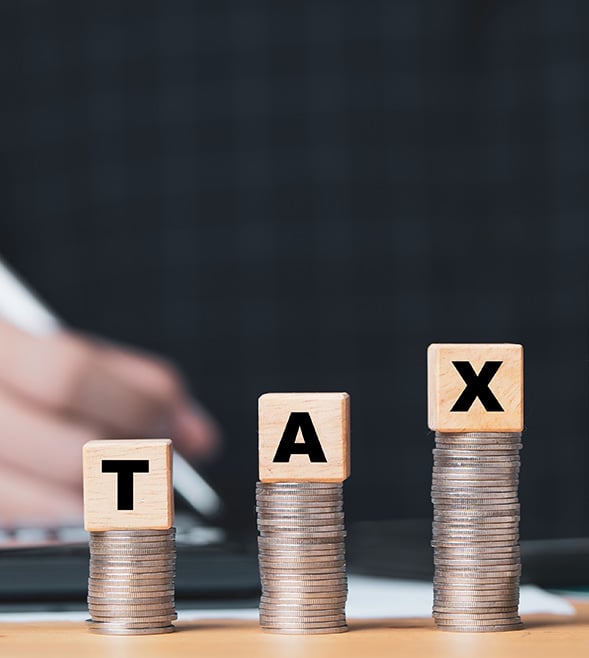-
Business Consulting
Our business consulting specialists offer a comprehensive blend of strategic advisory services. We assess the business, industry, operating model, synergy, skill sets and vision of the organisation and recommend the way forward
-
Digital Natives
Unlock growth with Grant Thornton Bharat's Digital Natives solutions. Customised support for tech-driven companies in healthcare, gaming, and more.
-
Digital Transformation Services
Grant Thornton’s digital transformation services help traditional businesses digitalise their business models with cloud technology, IoT consulting, app development and more DigiTech solutions.
-
Finance Transformation
Using a holistic approach, integrating digitalisation and digital transformation we help clients achieve transparency, control, governance, and faster decision making through real-time data within the business.
-
Human Capital Consulting
Our Human Capital Consulting team harnesses technology and industry expertise to assist in constructing adaptable organisations with transparency, fostering productive and value-driven workforces, and inspiring employees to engage meaningfully in their tasks.
-
Production Linked Incentive Scheme
Production-linked Incentive Scheme by the Indian government is aimed at boosting manufacturing. Grant Thornton Bharat offers varied services across sectors to help businesses avail of this scheme.
-
Public Sector Advisory
Our Public Sector Advisory team has focused streams, aligned with the core priorities of the Government of India. We are responsible for providing innovative and customized technical and managerial solutions.
-
Tech Advisory
We have amalgamated Digital Transformation, IT Advisory & Information Management and Analytics into a new offering, DigiTech.

-
Direct Tax services
Our tax specialists offer a comprehensive blend of tax services, tax litigation, regulatory and compliance services, helping you navigate through complex business matters.
-
Indirect Tax Services
Get tax services by leading tax firm Grant Thornton India. Our indirect tax services include consulting, compliance and litigation services for corporate, international and transaction tax
-
Transfer pricing services
Our transfer pricing services experts provide a range of services from provision of APA services to handling large global assignments including Country by Country reporting.
-
US Tax
At Grant Thornton, we help individuals and dynamic companies deal with US tax laws, which are one of the most complicated tax legislations across the world.
-
Financial Services - Tax
Best financial advisory services, tailored for small and large businesses by the experts having comprehensive knowledge of domestic laws and access to multifaceted tools to provide a valuable results.
-
Financial Reporting consulting services
Our experts have significant hands-on experience in providing IFRS/US GAAP services, end-to-end solutions and support services to fulfil financial reporting requirements.
-
Fund accounting and financial reporting
International operations often lack standardisation and have varied local reporting formats and requirements. Our experts can offer proactive insights, practical guidance, and positive progress and help meet regulatory timeframes.
-
Compliance and Secretarial Services
Our experts can assist in overhauling the entire compliance machinery of the organisation through evaluation of the applicable statutory obligations, monitoring of adequate governance controls, reporting and providing ongoing support.
-
Global People Solutions
As businesses transcend borders, both domestic and global considerations need equal attention. Our interim CFO and financial controller support services help organisations meet the business vision.
-
Finance and accounting outsourcing
Our accounting experts assist organisations in managing their accounting and reporting. Our dedicated Integrated Knowledge and Capability Centre (IKCC), allows us to service both the domestic and global markets efficiently and cost-effectively
-
Compliance Management System
We have automation solutions for you that will allow meeting government requirements and remain diligent, which when failed, can lead to penalties and loss in revenue.
-
Global compliance and reporting solutions
At Grant Thornton Bharat, we meet the challenges of our clients and help them unlock their potential for growth. Our professionals offer solutions tailored to meet our clients’ global accounting and statutory reporting requirements. With first-hand experience of local reporting requirements in more than 145+ locations worldwide, we provide seamless and consistent international service delivery through a single point of contact.
-
Related-party transaction governance
Related-party transactions (RPTs) are common in business structures where organisations engage with their group entities, such as holding companies, subsidiaries, associate concerns, joint ventures, or key management personnel, for various operational or financial purposes.
-
Family Offices & Private Client Services
Grant Thornton Bharat Private Client Services offers tailored advisory for family-owned businesses, focusing on governance, compliance, tax, succession planning, and family office structuring to sustain wealth and preserve legacies across generations.
-
GTMitra: Tax & Regulatory Tool
GTMitra, a specialised tax and regulatory tool by Grant Thornton Bharat, supports multinational businesses in understanding laws and regulations for effective growth strategies.
-
Labour codes
Labour codes solutions help you transition through the new legislation. At Grant Thornton, we help businesses divide their approach to make sure a smooth transition.
-
Alerts
At Grant Thornton India, with the help of our tax alerts, we help to provide updates on how to minimise your tax exposure and risks.
-
Unlocking opportunities: India investment roadmap
The India Investment Roadmap resource is designed to navigate the complexities of Indian tax and regulatory laws, providing seamless guidance and a comprehensive set of solutions to ensure a smooth process for investors aiming to establish or expand their presence in India.
-
CFO Solutions
Our comprehensive suite of solutions for CFOs

-
Cyber
In today’s time, businesses have gone through large transformation initiatives such as adoption of digital technologies, transition to cloud, use of advanced technologies et al.
-
Risk Optimisation
Our Governance, Risk and Operations (GRO) services encompass Internal Audit, Enterprise Risk Management, Internal Financial Controls, IT advisory, Standard Operating Procedures and other services.
-
Risk analytics
Grant Thornton Bharat’s CLEARR Insights is a state-of-the art data analytics platform that will help you in seamless data analysis and efficient decision-making.
-
Forensic & Investigation Services
The team of forensic advisory services experts consists of the best intelligence corporate experts, and fraud risk, computer forensic experts to deliver most effective solutions to dynamic Indian businesses.
-
Digital Forensics and Incident Response (DFIR)
Strengthen cyber resilience with proactive forensic audits
-
ESG consulting
Grant Thornton Bharat offers holistic ESG consulting solutions for sustainable business outcomes. With industry expertise and AI technology, we drive long-term value.

-
Transaction Tax Services
Our transaction tax experts understand your business, anticipate your needs and come up with robust tax solutions that help you achieve business objectives ensuring compliance and efficiency
-
Deal Advisory
Unlike other M&A advisory firm in India, we offer deal advisory services and work exclusively with controlled and well-designed strategies to help businesses grow, expand and create value.
-
Due Diligence
Grant Thornton’s financial due diligence services are aimed at corporate looking for mergers and acquisitions, private equity firms evaluating investments and businesses/promoters considering sale/divestment.
-
Valuations
As one of the leading valuation consultants in India, Grant Thornton specializes in all the aspects of the process like business valuation services, financial reporting, tax issues, etc.
-
Overseas Listing
Overseas listing presents a perfect platform for mid-sized Indian companies with global ambitions. Grant Thornton’s team of experts in listings, work closely with clients during all stages.
-
Debt & Special Situations Solutions
Grant Thornton Bharat offers specialist debt and special situations consulting services, including restructuring, insolvency, and asset tracing solutions.
-
Financial Reporting Advisory Services
Grant Thornton Bharat Financial Reporting Advisory Services offer end-to-end solutions for complex financial requirements, including GAAP conversions, IPO support, and hedge accounting advisory, ensuring accurate financial reporting and compliance.
-
Financial Statement Audit and Attestation Services
Grant Thornton Bharat offers customised financial statement audit and attestation services, ensuring impeccable quality and compliance with global standards. Our partner-led approach, technical expertise, and market credibility ensure effective solutions for your business needs.

- Agriculture
- Asset management
- Automotive and EV
- Banking
- Education and ed-tech
- Energy & Renewables
- Engineering & industrial products
- Fintech
- FMCG & consumer goods
- Food processing
- Gaming
- Healthcare
- Urban infrastructure
- Insurance
- Media
- Medical devices
- Metals & Mining
- NBFC
- Pharma, bio tech & life sciences
- Real estate and REITs
- Retail & E-commerce
- Specialty chemicals
- Sports
- Technology
- Telecom
- Tourism & hospitality
-
 Thought leadership Co-lending in India: Expanding credit access for MSMEsIn today’s rapidly evolving financial landscape, co-lending has emerged as a key enabler of credit expansion in India, facilitating partnerships between banks and non-banking financial companies (NBFCs) to extend credit more efficiently to underserved segments.
Thought leadership Co-lending in India: Expanding credit access for MSMEsIn today’s rapidly evolving financial landscape, co-lending has emerged as a key enabler of credit expansion in India, facilitating partnerships between banks and non-banking financial companies (NBFCs) to extend credit more efficiently to underserved segments. -
 Article Why India’s financial inclusion journey needs to focus on equity and access to creditFinancial services have expanded over a decade, giving millions access to bank accounts and digital payments. But true empowerment needs to reach every corner of the country if growth is to be long-term and sustained
Article Why India’s financial inclusion journey needs to focus on equity and access to creditFinancial services have expanded over a decade, giving millions access to bank accounts and digital payments. But true empowerment needs to reach every corner of the country if growth is to be long-term and sustained -
 Thought Leadership Competitive and sustainable agriculture & food processing in KeralaThe economy of Kerala is primarily driven by the services sector, which contributes 66% to the Gross State Domestic Product (GSDP).
Thought Leadership Competitive and sustainable agriculture & food processing in KeralaThe economy of Kerala is primarily driven by the services sector, which contributes 66% to the Gross State Domestic Product (GSDP). -
 Article Economic Survey 2024-25: Deregulation, investment and innovation for a Viksit BharatIndia's economic growth remains for a steady trajectory with real GDP expected to grow at 6.4% in FY25 and in the range of 6.3%-6.8% in FY26, reflecting resilience despite global uncertainties.
Article Economic Survey 2024-25: Deregulation, investment and innovation for a Viksit BharatIndia's economic growth remains for a steady trajectory with real GDP expected to grow at 6.4% in FY25 and in the range of 6.3%-6.8% in FY26, reflecting resilience despite global uncertainties.
-
Quarterly Aviation Insights
Explore the latest trends in aviation industry with Grant Thornton Bharat’s Quarterly Aviation Insights. Stay updated on industry growth, market shifts & key developments.

-
Freight Forward: Quarterly insights
Logistics sector in India is adapting to rising costs, global disruptions, and the growing urgency of sustainability.
-
India-UK
India-UK

The recently concluded COP 27, the 27th annual UN meeting on climate change in Sharm el-Sheikh, Egypt ended on a positive note with a deal to create a fund to help poor countries deal with climate-related disasters. While there is still ambiguity on the size of the fund and its contributors, the impact of this decision will be huge. Poor countries often are hit first and worst by climate change and are least able to cope with the risks. The fund will help them build resilience to natural disasters in order to better manage the risks these disasters pose.
While COP 26 was all about ‘Uniting the world to tackle climate change’, the motto of COP 27 was ‘Together towards implementation’, underlying the importance of joint efforts in tackling climate change. The key goal of the COP 26 conference was to obtain commitments to the 1.5-degree reduction target: phasing out coal, reducing methane emissions, halting deforestation, and accelerating the adoption of electric vehicles. These pledges are remarkable, but they only reduce projected global warming from 2.2 to 1.8 degrees, which is not nearly enough for us to avoid the most dangerous effects of climate change.
This year, we have seen a shift in focus toward implementing current climate plans, rather than campaigning for additional pledges. The plans include reducing emissions, helping countries prepare for climate change, and securing technical support/funding for developing countries. The key takeaway from COP 27 was to limit global warming to 1.5 °C above pre-industrial levels which would require “rapid, deep and sustained reductions in greenhouse gas emissions,” by 2030. This can be achieved through practical policies and measures by all countries combined with ambitious efforts to promote sustainable development and universal access to clean energy, especially in developing countries.
We have a unique opportunity to create global momentum on climate action by ensuring that all countries share the responsibility of climate progress in a fair manner. The Paris Agreement allows countries to set their own emission reduction targets. At COP 27, the European Union (EU), which is the world’s third biggest polluter after China and the United States announced plans to update its emissions-cutting target before the next COP to show its commitment to fighting climate change. EU has said that it would reduce its net greenhouse gas emissions by 55% by 2030 and eliminate them by 2050. This commitment is part of the EU Green deal, which is a package of tax and non-tax measures to reduce missions.
Taxes have always been an integral part of climate change discussions, and a windfall tax on carbon profits has long been on the table. Other fees and taxes such as methane fees or a carbon-damages tax on fossil-fuel companies are under consideration to lower emissions. Carbon taxes are popular in the EU, with 19 European countries implementing carbon taxes ranging from less than €1 per metric ton of carbon emissions in Poland and Ukraine to over €100 in Sweden, Liechtenstein, and Switzerland.
EU’s Green deal also allows countries to impose their own environmental taxes. In April 2022, the UK introduced a Plastic Packaging Tax (PPT), which applies at a rate of £200 per tonne on plastic packaging with less than 30% recycled plastic, manufactured or imported into the UK. Until recently, Spain had a high sales tax on natural gas at 21%, which it has now slashed to 5% to help consumers face rising energy costs this winter. In 2020, the total environmental tax revenue in the EU amounted to €300.5 billion, representing 2.2 % of the EU GDP and 5.4 % of total EU government revenue from taxes and social contributions, according to information from Eurostat. These taxes provide an incentive to produce cleaner energy, with many European countries using their revenues for public services and goods that reduce greenhouse gas emissions.
Apart from levying taxes, tax incentives such as lower tax rates for goods whose production has low to zero carbon emissions are also under consideration to help in a quick transition to green energy. Countries can also consider introducing taxes on highly polluting activities and products such as private jets to discourage their consumption. According to the World Inequality Report 2022, 19 global inequalities in emissions are now mainly due to within-country inequalities. These account for nearly two-thirds of global inequalities in emissions. The most pronounced of these inequalities are found in China and India as well as some other countries with well-developed economies.
The wealthiest 10% of the world’s population is responsible for around half of the global carbon emissions. While the bottom half of income groups in Europe and the USA reduced per capita emissions by 15–20% between 1990 and 2019, the wealthiest 1% increased their emissions significantly everywhere. The government's strategy on carbon taxes seems to have little impact on their consumption. High taxes on certain carbon-intensive spending and regulation of what can be consumed would be far more effective at reducing emissions.
Businesses will need to keep an eye on the developments that transpired at COP 27 and future climate summits because of their potential to result in national targets, laws, regulations, and policies that they will need to comply with. The decisions made at the summit could result in obstacles for businesses or opportunities for them. An entirely new consumption culture that demands environmentally sustainable products has emerged everywhere. Think about it; businesses will have to find ways to get their products to consumers without relying on fossil fuels or other non-renewable resources. We need to figure out how things can be recycled and put back into use without there being so much waste in the world. Consumers, investors, employees, and other stakeholders all care about climate change and businesses will have to think of ways to unlock the potential that this offers to create sustainable business models that serve everyone’s interests. A more sustainable future will have to be embraced by all businesses as it's inevitable.
